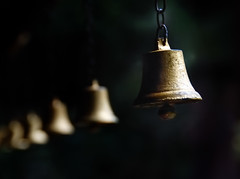Sound is generally the second easiest for us to remember to include. Little sound cues from knocking at the door, to a ringing phone to church bells to footsteps provide transitions and introduce characters. Technically, dialogue is a sound, but I think readers seldom process it that way (and that’s probably good), unless we specifically call attention to the way a line of dialogue is delivered.
 Of course, we don’t want to use too much sound—especially not if we bring sound to the forefront as with the above (and even more so if we do this more than once in a scene). While sight will be used in pretty much every scene (even if we don’t need description), sound probably won’t play quite as prominent a role.
Of course, we don’t want to use too much sound—especially not if we bring sound to the forefront as with the above (and even more so if we do this more than once in a scene). While sight will be used in pretty much every scene (even if we don’t need description), sound probably won’t play quite as prominent a role.
Hearing the scene
Sound generally doesn’t ground us as strongly as sight does, but it can still enhance a sense of setting and scene. Here are some tricks I use to focus on the sound in a scene:
- Close your eyes. What are the background noises in this setting (traffic, natural, people, etc.)? Does the character notice them—or would s/he notice if they disappeared?
- Look for missed opportunities to set the stage with sound. What sounds are (fairly) unique to this setting, that could help to ground your characters and readers and convey a sense of place?
- Don’t neglect the dialogue. Are there any lines of dialogue that need a little help conveying their full meaning or emotional impact? (Yes, make sure the dialogue is as strong as possible on its own first, but if it’s still not enough—or if the words contradict the speaker’s meaning—add to the tone.)
- Closely related: Read the scene aloud for cadence. Does the rhythm of the words sound natural, and does it fit the scene?
Silence is golden
Don’t neglect silence as a part of sound. Whether it’s an awkward pause in a conversation or the still that falls over forest birds when a predator is near, silence can convey as much meaning as sound, if used properly.
What do you think? How do you use sound in your scenes?
Photo by David Boocock
